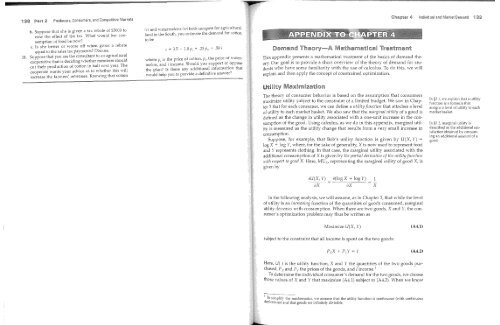Daniel l. Rubinfeld
Daniel l. Rubinfeld
Daniel l. Rubinfeld
You also want an ePaper? Increase the reach of your titles
YUMPU automatically turns print PDFs into web optimized ePapers that Google loves.
138 Part 2 Producers, Consumers, and Competitive Markets<br />
4 Individual and Market Demand<br />
11.<br />
b. Suppose that she is given a tax rebate of 515000 to<br />
ease the effect of the tax~ What would her consumption<br />
of food be now<br />
c. Is she better or worse off when given a rebate<br />
equal to the sales tax payments Discuss. .<br />
Suppose that you are the consultant to an agncultural<br />
cooperative that is deciding whether members should<br />
cut their production of cotton in half next yea.I. Tl:e<br />
cooperate wants your advice as to whether this will<br />
that cotton<br />
(c) and watermelons (lUJ both compete for ag~icultural<br />
land in the South, you estimate the demand tor cotton<br />
to be<br />
where Pc is the price of cotton, V,· the price of watermelon,<br />
and i income. Should you support or oppose<br />
the plan Is there any additio~1a.l.informati~n that<br />
would help you to provide a definitive answer.<br />
This appendix presents a mathematical treatment of the basics of demand theory.<br />
Our goal is to provide a short overvie'w of the theory of demand for stud~nts<br />
who have some familiarity with the use of calculus~ To do this, we will<br />
explain and then apply the concept of constrained optimization.<br />
Maximization<br />
The theory of consumer beha\'ior is based on the assumption that consumers<br />
maximize utility subject to the constraint of a limited budget. We saw in Chapter<br />
3 that for each consumer, we can define a lltility jllllctioll that attaches a level<br />
of utility to each market basket. We also saw that the IIlmginalutility of a good is<br />
defined as the change in utility associated with a one-unit increase in the consumption<br />
of the good. Using calculus, as \ve do in this appendix, marginal utility<br />
is measured as the utility change that results from a very small increase in<br />
consumptiorL<br />
Suppose, for example, that Bob's utility function is given by U(X, Y) =<br />
log X + log Y, ,,>'here, for the sake of generality, X is now used to represent food<br />
and Y represents clothing. In that case, the marginal utility associated with the<br />
additional consumption of X is given by the pm·tial derivative oj the utility jUllction<br />
witiz respect to good K Here, MU x' representing the marginal utility of good X, is<br />
aiven by<br />
tJ ~<br />
In §3J, we explain that a utility<br />
function is a formula that<br />
assigns a level of utility to each<br />
market basket<br />
In §3~ 2, marginal utility is<br />
described as the additional satisfaction<br />
obtained by consuming<br />
an additional a~ount of a<br />
good<br />
CiU(X, Y)<br />
ax<br />
a(log X + log Y)<br />
ax<br />
1<br />
X<br />
In the following analysis, \ve will assume, as in Chapter 3, that while the level<br />
of utility is an increasing function of the quantities of goods consumed, marginal<br />
utility decreases with consumption. When there are h'\'o goods, X and Y, the consumer's<br />
optimization problem may thus be written as<br />
Maximize U(X, Y)<br />
(A4.1)<br />
subject to the constraint that all income is spent on the hvo goods:<br />
(A4.2)<br />
Here, U( ) is the utility function, X and Y the quantities of the two goods purchased,<br />
P x and Py the prices of the goods, and I income. 1<br />
To determine the individual consumer's demand for the two goods, we choose<br />
those values of X and Y that maximize (A4.1) subject to (A4.2)~ When we know<br />
simplify the mathematics, we assume that the utility function is continuous (with continuous<br />
and that goods are infinitely divisible

















